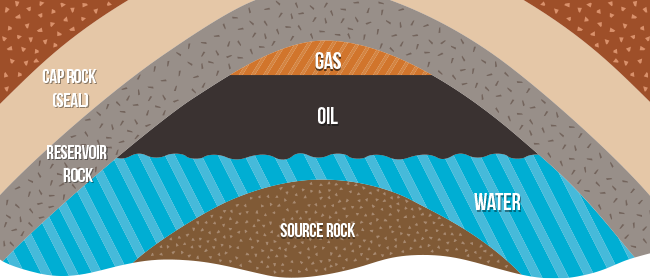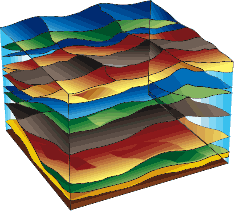Rock Hounds Who Sniff Out Gas
The pilot light on your stove goes out and your kitchen begins to smell like rotten eggs. Gas leak, you think to yourself. But that’s not gas you smell. It’s a chemical called mercaptan, which the gas company has added to make it easy for you to detect a leak. Natural gas itself is colorless and odorless. So how do gas companies find it underground?
“There are a lot of ways to look for oil and natural gas,” says James A. Gibbs, a consulting petroleum geologist and independent oil and gas producer in Dallas, Texas. An oil seep on the surface of the ground is one telltale sign of gas below, since oil and gas are usually found together. Soil and airborne gas surveys that detect the presence of gas molecules in surface soil and air are another way of finding clues about the possible location of oil and gas. These methods are just the first step though, says Gibbs. What you really need to do is find the underground trap.
A petroleum geologist knows that in order for gas to be present underground, there must be a source rock that produced the gas, a porous reservoir rock (usually sandstone or limestone) that holds the gas, and an overlying bed of impervious rock, called a seal, above the reservoir rock to keep the gas from escaping. This configuration of rocks that allows the gas to be contained is called a trap.

How does a petroleum geologist find a trap? He or she might begin by examining aerial and satellite photographs of the site and mapping the surface. “From these surface maps,” explains Gibbs, “the geologist can project the geometry of the surface into the subsurface to see what rocks may be at depth.” The geologist might also make subsurface maps from data obtained by existing wells nearby.
The geologist will also conduct a number of tests—including gravity, magnetic, and seismic surveys—that supply data about the properties of the rocks below and thereby help the scientist to determine where these gas traps are located. “So you’re not really looking directly for the hydrocarbon, you’re looking for where the hydrocarbon might be,” says Gibbs.
Conducting a Seismic Survey
During a seismic survey, listening devices, called geophones, are placed in a line or checkerboard pattern on the ground. Then a series of shock waves—produced either by a dynamite blast or by special trucks equipped with pounding or vibrating machines—are sent underground. Wherever there is a change in the density of rock, which can occur between layers, the sound waves bounce back to the surface and are recorded by the geophones. The data is then assembled by computer in a two- or three-dimensional record called a seismogram.

But even then, says Gibbs, “the only definitive test that you have for hydrocarbons is, unfortunately, a bore hole—a well. Because even though you’ve done everything you possibly can to determine the presence of a trap, you may get down there and find that the reservoir rock that you expected to see [is] plugged up.”
Gibbs adds, “It’s like a puzzle or an investigation, in which you take all these geological clues and you match your wits against the rocks and try to imagine where oil and gas could occur.”
Help Prevent Gas Leaks
 If people dig into natural gas pipelines, the gas can leak out and become a fire hazard. So if you or someone you know is planning a digging project, be sure to call the utility locator service at 811 several days before digging. This service makes sure underground gas pipelines and other utilities are clearly marked so people can dig a safe distance away.
If people dig into natural gas pipelines, the gas can leak out and become a fire hazard. So if you or someone you know is planning a digging project, be sure to call the utility locator service at 811 several days before digging. This service makes sure underground gas pipelines and other utilities are clearly marked so people can dig a safe distance away.
Learn the Warning Signs
Gas utilities add a highly recognizable sulfur-like odor to natural gas to assist in leak detection. But don’t rely on your nose alone. Be alert for any of these gas leak warning signs:
- A sulfur-like or rotten-egg smell
- A hissing, whistling, or roaring sound
- Dirt blowing or spraying into the air
- Continuous bubbling in water
- Grass or plants dead or dying for no apparent reason
What to Do
If you suspect a gas pipeline leak, go far away from the area immediately and do NOT go back until safety officials say it is safe. Do not use electricity or fire. Even the tiniest spark from a phone, flashlight, or match could ignite the gas.
If you suspect a gas leak in your home, get everyone out of the house and go to a safe location. Do not use a light switch, candle, flashlight, TV, radio, garage door opener, or any kind of phone.
In both cases, report the leak to 911 and the local natural gas utility from a safe location.
Gas Moves Fast
A gas is a substance whose molecules are in constant, rapid, random motion. As a result, a gas will spread out and take on the shape and volume of whatever container it is in—whether a jar, a room, or the atmosphere! This is very different from a liquid or a solid. The molecules in a liquid do not move as fast as those in a gas. A liquid can take on the shape of its container but will keep the same volume, no matter what container it is in. The molecules in a solid just vibrate in place. That is why a solid will retain both its shape and its volume.
Advanced Science Concept
Fantastic Facts
- How much methane do cows produce? The average cow’s digestive tract releases 600 liters of methane per day—enough to fill 40 party balloons!
- How does the United States rank globally in terms of natural gas reserves? The United States actually ranks fifth in the size of its natural gas reserves. The Russian Federation has tremendous reserves (1,320 trillion cubic feet), followed by Iran (1,133 trillion cubic feet), Qatar (871 trillion cubic feet), Turkmenistan (480 trillion cubic feet), the United States (445 trillion cubic feet), Saudi Arabia (212 trillion cubic feet), and the United Arab Emirates (209 trillion cubic feet).(Source: BP Statistical Review of World Energy 2021)
- Who invented rotary drills? The Egyptians are credited with a first in drilling technology: they used rotary drilling mechanisms as early as 3000 B.C. In 1500 A.D., Leonardo da Vinci developed a design for a drilling rig that is similar to many of those used today to locate natural gas deposits.


